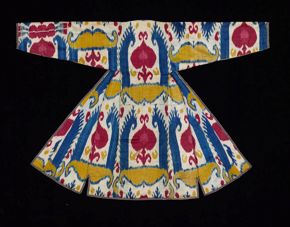In-Gallery Extras for “Colors of the Oasis”: Getting Our Hands Dirty So You Don’t Have To! March 16, 2017

Central Asia, Uzbekistan, Bukhara, Woman's Robe (Munisak), late 19th century, silk and cotton, the Textile Museum, the Megalli Collection, Washington, D.C.
When I first began researching the ikat textiles of the exhibition Colors of the Oasis: Central Asian Ikats, I had no idea it would lead to being up to my elbows (literally) in crushed insects.
For the past few months, I’ve been trying out the techniques and processes that were used to create the exhibition’s textiles and vivid colors, including the wide range of flowers, roots, insects, and other natural materials. This research has led to the development of interactive experiences for exhibition visitors, including:
• A touchscreen kiosk exploring dye materials
• A video demonstrating ikat production
• An exhibition guide with discussion starters and activities for all ages
• A hands-on Discovery Cart featuring traditional dye materials
What Are Ikats?
The word “ikat” (pronounced ee-kaht) is derived from the Malay word mengikat, meaning “to tie or bind.” Most fabric is dyed after it is woven, but the yarn that makes up an ikat is dyed before weaving. Sections of the yarn are tied off with binding to protect it from absorbing dye. When the dyed yarn is unbound, patterns emerge between the undyed and dyed sections.

Yarn is tied in preparation for ikat dying. Image courtesy of Matter Prints
Explore More with the Interactive Kiosk
To highlight the importance of the dyer’s craft, we created a touchscreen kiosk for the exhibition featuring a multimedia-rich exploration of the plants, insects, and other natural materials used to create the vivid range of hues seen in Colors of the Oasis, with a look at how these materials are also used in the present day.

The exhibition’s touchscreen kiosk features information on a range of natural dye-materials, how they would have been used in 19th-century Central Asia, and how they are used today.
The kiosk includes images, videos, and research collected from natural-dye experts and hobbyists around the world, including the Contemporary Handweavers of Houston (CHH).
Get Hands-on with Natural Dyes at the Discovery Cart
I was fortunate enough to spend an afternoon with several members of the CHH, who gave me a crash course in natural dyes.

Silk yarn is lowered into a pot of red dye created with cochineal insects. Image courtesy of the Contemporary Handweavers of Houston
Over the course of a few hours, we created a rainbow of silk and wool yarn. We used simple, everyday plant materials such as marigold flowers and walnut hulls, as well as specialized natural materials such as cochineal insects and indigo, to create the range of colors seen below.

Yarn dyed with natural materials hangs to dry. Image courtesy of the Contemporary Handweavers of Houston
At the Museum, we’ve used the dyed yarn and dye materials to stock a Discovery Cart. This mobile demonstration of artistic technique enables visitors to handle materials for themselves during many of the exhibition’s docent-led tours.

The Discovery Cart in the galleries of Colors of the Oasis.
Watch a Complex Process
Also in the exhibition galleries is a video detailing the complex process of dyeing ikat. The film documents contemporary ikat production, which includes very similar processes used by the 19th-century artisans who created the ikats on view in Colors of the Oasis. The footage was provided by Matter Prints, a clothing company that uses traditional textiles.

A woman binds yarn in order to create an ikat textile. Film still courtesy of Matter Prints
Experience Everything for Yourself!
Our goal for the film, and for the other interpretative elements you’ll find throughout the exhibition, is to illuminate some of the complex knowledge and skills required to create ikat textiles. We hope these elements enliven and enrich your experience!
Try out these in-gallery extras when you visit “Colors of the Oasis: Central Asian Ikats,” on view in the Beck Building through June 4.





